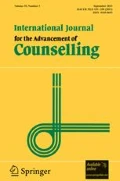Abstract
Children in Kenya’s Kisumu District Primary Schools (N = 430) completed three measures of trauma. Respondents completed the My Worst Experience Scale (MWES; Hyman and Snook 2002) and its supplement, the School Alienation and Trauma Survey (SATS; Hyman and Snook 2002), sharing their worst experiences overall and specifically in schools. Participants also completed the Trauma and Attachment Belief Scale (TABS; Pearlman 2003), addressing their experiences of violence. The study examined children’s perceptions about themselves and others in the aftermath of violent experiences and the relationship between children’s trauma symptoms from experiencing violence and their social and academic functioning. Differences in the presence, frequency, and severity of symptoms emerged, with a large percentage attaining statistical and clinical significance. Research and practice implications are provided.
Similar content being viewed by others
References
Allwood, M. A., Bell-Dolan, D., & Husain, S. A. (2002). Children's trauma and adjustment reactions to violent and nonviolent war experiences. Journal of the American Academy of Child and Adolescent Psychiatry, 41(4), 450–457.
Giacaman, R., Abu-Rmeileh, N. M. E., Husseini, A., Saab, H., & Boyce, W. (2007). Humiliation: The invisible trauma of war for Palestinian youth. Public Health, 121(8), 563–571.
Giaconia, R. M., Reinherz, H. Z., Hauf, A. C., Paradis, A. D., Wasserman, M. S., & Langhammer, D. M. (2000). Comorbidity of substance use and posttraumatic stress disorder in a community of adolescents. The American Journal of Orthopsychiatry, 70(2), 253–262.
Henrich, C. C., Schwab-Stone, M., Fanti, K., Jones, S. M., & Ruchkin, V. (2004). The association of community violence exposure with middle-school achievement: A prospective study. Journal of Applied Developmental Psychology, 25(3), 327–348.
Hyman, I. A., & Snook, P. A. (2002). My Worst Experience Scale (MWES)-Manual. Los Angeles, CA: Western Psychological Services.
Kenya Red Cross Society Post-Election Violence Update. (2008). Kenya Humanitarian Forum Meeting, 28 March 2008. Post Election Violence Update. Retrieved from http://tiny.cc/y51f7.
Morgos, D., Worden, J. W., & Gupta, L. (2008). Psychosocial effects of war experiences among displaced children in southern Durfur. Omega, 56(3), 229–253.
Okech, J. E. A., & Kimemia, M. (2012). Professional Counseling in Kenya: History, current status, and future trends. Journal of Counseling and Development, 90, 107–118.
Pearlman, L. A. (2003). Trauma and Attachment Belief Scale (TABS). Los Angeles, CA: Western Psychological Services.
Quota, S., & Sarraj, E. E. (2004). Prevalence of PTSD among Palestinian children in Gaza Strip. Arabpsynet Journal, 2, 8–13.
Ratner, H. H., Chiodo, L., Covington, C., Sokol, R. J., Ager, J., & Delaney-Black, V. (2006). Violence exposure, IQ, academic performance, and children’s perception of safety: Evidence of protective effects. Merrill-Palmer Quarterly, 52(2), 264–287.
Scales, P. C., Benson, P. L., Roehlkepartain, E. C., Sesma, A., & van Dulmen, M. (2006). The role of developmental assets in predicting academic achievement: A longitudinal study. Journal of Adolescence, 29(5), 691–708.
Schwartz, D., & Gorman, A. H. (2003). Community violence exposure and children’s academic functioning. Journal of Educational Psychology, 95(1), 163–173.
Seedat, S., Nyamai, C., Nienga, F., Vythilingum, B., & Stein, D. J. (2004). Trauma exposure and post-traumatic stress symptoms in urban African schools. Survey in Cape Town and Nairobi. The British Journal of Psychiatry, 184, 169–175.
Smyth, M., Fay, M. T., Brough, E., & Hamilton, J. (2004). The impact of political conflict on children in Northern Ireland: A report on the community conflict impact on children study. Belfast: Institute for Conflict Research.
Solber, V. S., Close, W., & Metz, A. J. (2002). Promoting success pathways for middle and high school students: Introducing the Adaptive Success Identity Plan for school counselors. In C. L. Juntunen & D. R. Atkinson (Eds.), Counseling across the lifespan: Prevention and treatment (pp. 135–157). Thousand Oaks, CA: Sage.
Suliman, S., Kaminer, D., Seedat, S., & Stein, D. J. (2005). Assessing post-traumatic stress disorder in South African adolescents: using the child and adolescent trauma survey (CATS) as a screening tool. Annals of General Psychiatry, 4, 1.
Thabet, A. A., & Vostanis, P. (2000). Post traumatic stress disorder reactions in children of war: A longitudinal study. Child Abuse & Neglect, 24(2), 291–298.
Underwood, L., Stewart, S. E., & Castellanos, A. M. (2007). Effective practices for sexually traumatized girls: Implications for counseling and education. International Journal of Behavioral Consultataion and Therapy, 3(3), 403–419.
United Nations Children's Fund. (2008, January 16). Hundreds of thousands of children suffer the consequences of the post-election crisis in Kenya. Retrieved from http://www.unicef.org/media/media_42441.html
United Nations Human Settlements Programme. (2010). Building prosperity through neighbourhood development. Retrieved from http://www.unhabitat.org/content.asp?cid=8278&catid=578&typeid=61
Vizek-Vidović, V., Kuterovac-Jagodić, G., & Arambaŝić, L. (2000). Posttraumatic symptomalogy in children exposed to war. Scadinavian Journal of psychology, 41(4), 297–306.
Wasco, S. M. (2003). Conceptualizing the harm done by rape: Applications of trauma theory to experiences of sexual assault. Violence, Trauma & Abuse, 4(4), 309–322.
Acknowledgements
This research was supported in part by a grant from the University of Vermont’s Office of the Vice-President for Research and Graduate Studies. The Kenya Female Advisory Organization (KEFEADO) generously provided a research administration office and storage facilities in Kisumu, Kenya. The author is also deeply indebted to Allan Howard of the University of Vermont’s Statistical Consulting Clinic (SCC) for his assistance in analyzing the data reported in this manuscript. The author thanks the students, administrators, teachers, parents, and guardians in the primary schools in Kisumu who participated in this investigation.
Author information
Authors and Affiliations
Corresponding author
Rights and permissions
About this article
Cite this article
Okech, J.E.A. A Multidimensional Assessment of Children in Conflictual Contexts: The Case of Kenya. Int J Adv Counselling 34, 331–348 (2012). https://doi.org/10.1007/s10447-012-9166-4
Published:
Issue Date:
DOI: https://doi.org/10.1007/s10447-012-9166-4




